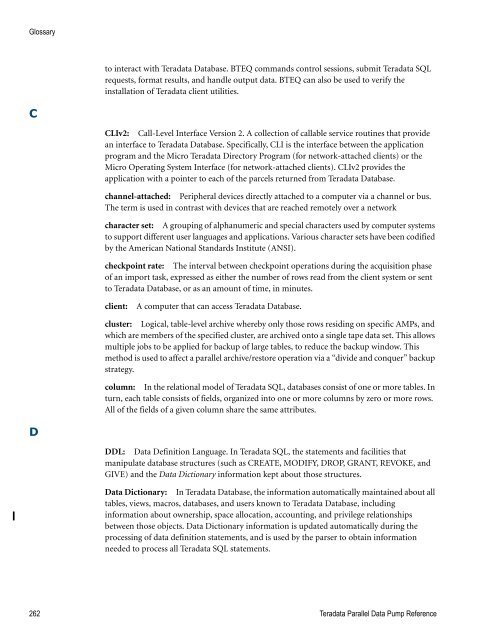Teradata Parallel Data Pump
Teradata Parallel Data Pump Reference - Teradata Developer ...
Teradata Parallel Data Pump Reference - Teradata Developer ...
- No tags were found...
You also want an ePaper? Increase the reach of your titles
YUMPU automatically turns print PDFs into web optimized ePapers that Google loves.
Glossary<br />
to interact with <strong>Teradata</strong> <strong>Data</strong>base. BTEQ commands control sessions, submit <strong>Teradata</strong> SQL<br />
requests, format results, and handle output data. BTEQ can also be used to verify the<br />
installation of <strong>Teradata</strong> client utilities.<br />
C<br />
CLIv2: Call-Level Interface Version 2. A collection of callable service routines that provide<br />
an interface to <strong>Teradata</strong> <strong>Data</strong>base. Specifically, CLI is the interface between the application<br />
program and the Micro <strong>Teradata</strong> Directory Program (for network-attached clients) or the<br />
Micro Operating System Interface (for network-attached clients). CLIv2 provides the<br />
application with a pointer to each of the parcels returned from <strong>Teradata</strong> <strong>Data</strong>base.<br />
channel-attached: Peripheral devices directly attached to a computer via a channel or bus.<br />
The term is used in contrast with devices that are reached remotely over a network<br />
character set: A grouping of alphanumeric and special characters used by computer systems<br />
to support different user languages and applications. Various character sets have been codified<br />
by the American National Standards Institute (ANSI).<br />
checkpoint rate: The interval between checkpoint operations during the acquisition phase<br />
of an import task, expressed as either the number of rows read from the client system or sent<br />
to <strong>Teradata</strong> <strong>Data</strong>base, or as an amount of time, in minutes.<br />
client:<br />
A computer that can access <strong>Teradata</strong> <strong>Data</strong>base.<br />
cluster: Logical, table-level archive whereby only those rows residing on specific AMPs, and<br />
which are members of the specified cluster, are archived onto a single tape data set. This allows<br />
multiple jobs to be applied for backup of large tables, to reduce the backup window. This<br />
method is used to affect a parallel archive/restore operation via a “divide and conquer” backup<br />
strategy.<br />
column: In the relational model of <strong>Teradata</strong> SQL, databases consist of one or more tables. In<br />
turn, each table consists of fields, organized into one or more columns by zero or more rows.<br />
All of the fields of a given column share the same attributes.<br />
D<br />
DDL: <strong>Data</strong> Definition Language. In <strong>Teradata</strong> SQL, the statements and facilities that<br />
manipulate database structures (such as CREATE, MODIFY, DROP, GRANT, REVOKE, and<br />
GIVE) and the <strong>Data</strong> Dictionary information kept about those structures.<br />
<strong>Data</strong> Dictionary: In <strong>Teradata</strong> <strong>Data</strong>base, the information automatically maintained about all<br />
tables, views, macros, databases, and users known to <strong>Teradata</strong> <strong>Data</strong>base, including<br />
information about ownership, space allocation, accounting, and privilege relationships<br />
between those objects. <strong>Data</strong> Dictionary information is updated automatically during the<br />
processing of data definition statements, and is used by the parser to obtain information<br />
needed to process all <strong>Teradata</strong> SQL statements.<br />
262 <strong>Teradata</strong> <strong>Parallel</strong> <strong>Data</strong> <strong>Pump</strong> Reference









